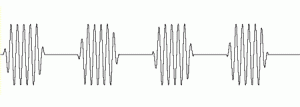A Better Way to Stimulate The Brain: Isochronic Tones
A Better Way to Stimulate The Brain: Isochronic Tones
What are isochronic tones?
Isochronic tones are a very effective audio-based method of stimulating the brain. You may have heard of another method called binaural beats. Both of these methods are examples of a complex neurological process known as brainwave entrainment (pronounced: “ehn - TRAIN - mint”), which enables the use of audio or visual stimuli to affect the brain and help people with a variety of problems. To learn more about brainwave entrainment, click here.
At its simplest level, an isochronic tone is just a tone that is being turned on and off rapidly. They create sharp, distinctive pulses of sound, as seen in the pattern below:

The volume or intensity of the sound goes almost directly from 0 to 100 and back again in an evenly-spaced manner. This leaves a stronger impression on the brain, compared to binaural beats or other methods that use wave-like pulses.
Additionally, isochronic tones differ from binaural beats in that they use a single tone, not two. The pulses that affect the brain are created manually by the software, so only a single tone is needed. This has several advantages. Headphones are no longer needed. And if headphones are worn, different frequencies can be sent to each ear, which is important for protocols used in certain studies.
Why use isochronic tones and other brainwave stimulation?
When isochronic tones are utilized as a stimulus under specific circumstances, research has shown evidence of beneficial outcomes such as anxiety reduction and increased concentration. Here are just a few of the reasons one might use this technology, with links to even more information and supporting research.
Cognition / Attention / Focus: A growing body of research is showing that brainwave stimulation can be an incredibly effective tool to promote attention and focus.
Stress Reduction: The sessions included in NP3 are designed to be naturally relaxing, but it also comes with sessions specifically designed for stress and anxiety.
Emotional Stability / Mood Support: Decades of neurofeedback research have revealed specific brainwave patterns characteristic of negative moods and overly emotional mental states. Based on this, brainwave entrainment sessions have been developed and recent research is showing it to be a very promising aide in this area. Learn more…
Study help: NP3 can help optimize the brain for studying- users consistently report being more productive and learning more quickly while using NP3.
Motivation / Energy: Many users report experiencing a great boost in energy as a result of NP3 sessions, including a “Wake Up” session that can replace caffeine!
Deep Meditation: Using NP3 can be likened to a form of “high tech” meditation, where audio and visual patterns are used to guide your mind to the relaxed, focused state experienced during meditation.
What science and research is this software supported by?
It is a recent development that the potential benefits of brainwave entrainment and isochronic tones have generated enough interest in the scientific community for research to be done. Despite this fact, there are already a number of published studies available documenting results from experiments with isochronic tones and additional entrainment methods (such as binaural beats, monaural beats, and photic stimulation - all of which are utilized in our software).
Here are three conclusions to published and peer-reviewed studies on brainwave entrainment:
“Findings to date suggest that BWE is an effective therapeutic tool. People suffering from cognitive functioning deficits, stress, pain, headache/migraines, PMS, and behavioral problems benefited from BWE.” Huang, T., Charyton, C., 2008. Alternative Therapies. Volume 14.1
- “The eight students from the SPALDING reading program who received AVE improved their reading scores more than their classmates who served as controls. The data suggests AVE was a useful experience for the participants. Parents and teachers reported the children were calmer and could focus better. The results met or exceeded our expectations.” Joyce, M, and Siever, D., 2000. Journal of Neurotherapy. Volume 4.2
- “Results suggest that this technology could greatly enhance the quality of life for learning-disabled individuals who, absent appropriate intervention, are at risk for social, psychological, and a multitude of personal disappointments and life-long failures.” Olmstead R. Use of auditory and visual stimulation to improve cognitive abilities in learning-disabled children. Journal of Neurotherapy. 2005;9(2):49-61
by Transparent Corp
Be the first to post a message!
